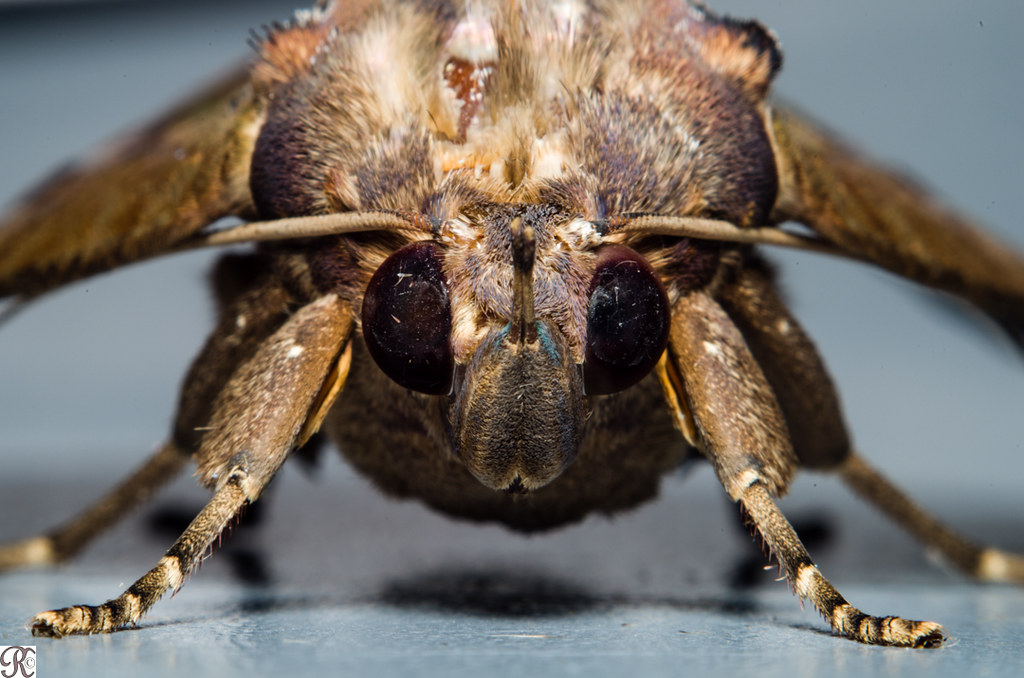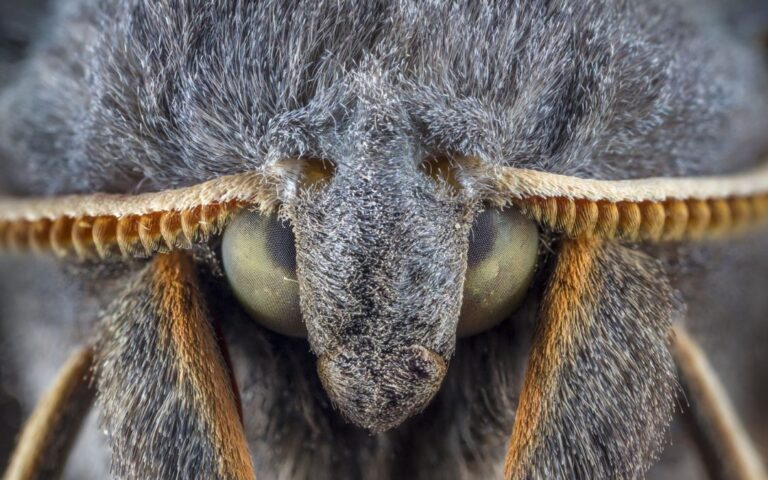Yes, moths, like most insects, have a brain. Their brain is a relatively simple and small structure compared to that of vertebrates, but it serves their basic neurological functions.
The moth’s brain helps it process sensory information, control its movements, and carry out essential behaviors such as finding food, avoiding predators, and mating.
The moth’s brain is composed of several ganglia, which are clusters of nerve cells (neurons) that are interconnected.
How does moth anatomy differ from other insects?
Moths are insects belonging to the order Lepidoptera, which also includes butterflies. Their anatomy shares common features with other insects but also exhibits unique adaptations suited to their ecological niche. Here’s a breakdown of the general structure of a moth:
Exoskeleton: Like all insects, moths have an exoskeleton, which is a rigid outer covering that provides support, protection, and resistance to desiccation. This exoskeleton is made of chitin.
Body Segmentation: A moth’s body is divided into three main segments: the head, thorax, and abdomen.
Furthermore, the head contains sensory organs, the thorax houses the legs and wings, and the abdomen holds most of the vital organs and the reproductive system.
Antennae: Moths have long, often feathery antennae that are used for detecting chemical cues, pheromones, and environmental stimuli. The antennae play a crucial role in their ability to navigate and find mates.
Wings: One of the most distinctive features of moths is their wings. Unlike butterflies, moth wings are typically more muted in color and have a variety of shapes and patterns.
In addition, moths are renowned for their ability to fly at night, and their wings are adapted for this purpose.
Mouthparts: Moths possess a specialized mouthpart structure designed for feeding on fluids.
Furthermore, this structure can vary among moth species, with some having long proboscises for reaching nectar in flowers, while others have shorter mouthparts adapted for chewing or piercing plant tissues.
Legs: Moths have six jointed legs attached to their thorax. These legs are used for walking, clinging to surfaces, and in some cases, for grasping prey.
Comparison of Moth Anatomy to Other Insects

To gain a deeper understanding of moth anatomy, it’s essential to compare it to the anatomy of other insects, particularly their close relatives, butterflies, and some broader insect characteristics:
Comparison to Butterflies: Moths and butterflies share a common ancestry and are collectively known as Lepidoptera. While they have similar basic body plans, there are notable differences:
Moths typically have thicker bodies with robust antennae, whereas butterflies have slender bodies and more slender antennae.
Additionally, moths are often nocturnal or crepuscular (active during dawn and dusk), while butterflies are diurnal (active during the day).
Moth wings are generally less colorful and more cryptic compared to the bright and vibrant colors of butterfly wings.
Common Insect Features: In addition to the differences between moths and butterflies, moths, like all insects, share some common features:
- They have a hard exoskeleton for protection.
- Insects exhibit metamorphosis, with moths undergoing complete metamorphosis, including egg, larva (caterpillar), pupa (chrysalis), and adult stages.
- Insects have a tracheal respiratory system, relying on a network of tubes to deliver oxygen directly to their tissues.
- Moths have compound eyes, which consist of many individual lenses, allowing them to detect motion and light intensity effectively.
Where is a moth’s brain located ?
Insects, including moths, have a highly organized and efficient nervous system adapted to their specific needs. The nervous system in insects consists of the following key components:
Central Nervous System (CNS): The central nervous system includes the brain and a chain of nerve ganglia (clusters of nerve cell bodies) that run along the ventral (underside) part of the insect’s body.
Moreover, these ganglia are responsible for processing sensory information, coordinating motor responses, and regulating various physiological functions.
Peripheral Nervous System (PNS): The peripheral nervous system consists of sensory neurons that detect external stimuli and transmit information to the CNS.
Moreover, it also includes motor neurons that transmit signals from the CNS to muscles and glands, allowing for coordinated movements and responses.
Sensory Organs: Insects, including moths, possess a variety of sensory organs, such as compound eyes for vision, antennae for olfaction (smell), and sensory hairs (setae) for touch and taste. These sensory organs play a crucial role in their ability to interact with the environment.
The Brain of a Moth
The brain of a moth is situated in the head, specifically in the region known as the insect’s cephalon. It is positioned above the esophagus and is connected to the ventral nerve cord, which runs along the length of the insect’s body.
While the moth’s brain is relatively small and less complex compared to the brains of vertebrates, it is well-suited to meet the insect’s needs. The size and complexity of the brain can vary among moth species, but it typically consists of a series of ganglia and interconnected nerve cells. These ganglia are responsible for processing sensory information and coordinating various behaviors.
How does it impact behavior?
The brain of a moth plays a central role in processing sensory information gathered from its environment. Moths rely heavily on their sensory systems to detect cues such as pheromones for mating, visual cues for navigation, and chemical signals for finding food sources. The brain integrates this sensory input to create a coherent perception of the world around them.
The brain also controls the moth’s motor functions, including the movement of its legs, wings, and other body parts.
This coordination is essential for activities such as flight, grooming, and foraging. Motor neurons originating in the brain send signals to the muscles, allowing the moth to perform precise and coordinated movements.
Moth behavior is closely linked to the functions of the brain. The brain processes sensory information and, in response, triggers appropriate behavioral responses.
For example, when a moth detects the scent of a potential mate’s pheromones, its brain may initiate a search and courtship behavior. Similarly, if a moth perceives a threat, its brain may activate escape or defensive behaviors.
How does the moth’s brain influence finding food?

Moths exhibit a wide range of behaviors and instincts that are finely tuned by their nervous system, particularly their brains. These behaviors are essential for their survival, reproduction, and adaptation to their environment:
Nocturnal Activity: Many moths are nocturnal, meaning they are primarily active at night. This behavior is thought to be an adaptation to avoid predators and take advantage of the reduced competition for resources in the dark.
Flight: Moths are strong fliers, and their ability to fly is a critical aspect of their behavior. They use flight for various purposes, such as searching for food, finding mates, and escaping predators.
Chemical Communication: Moths are known for their intricate chemical communication through the release and detection of pheromones. Male moths can detect the pheromones emitted by females, which leads to the successful location and mating with a potential mate.
Feeding: Moths have diverse feeding habits. Some species feed on nectar from flowers, acting as pollinators, while others may feed on other fluids like sap, fruit juices, or even blood (in the case of certain blood-feeding moths). The brain plays a role in coordinating feeding behaviors and locating suitable food sources.
Camouflage and Defense: Moths often rely on camouflage to avoid detection by predators. They may have color patterns on their wings that resemble their surroundings, helping them blend in. If threatened, moths may engage in evasive flight maneuvers or employ other defense mechanisms.
How the Brain Influences Moth Behavior
Finding Food: The moth’s brain is responsible for processing sensory information, including olfactory cues from its antennae. When a moth detects the scent of a flower or other potential food source, its brain processes this information and guides the insect toward the source.
The brain also regulates feeding behaviors, such as proboscis extension and nectar intake, ensuring efficient energy acquisition.
Avoiding Predators: The brain plays a crucial role in detecting and responding to threats from predators. When a moth senses the presence of a predator, such as a bat or bird, its brain initiates a fight-or-flight response.
Flight is often the primary defense mechanism, and the moth’s brain coordinates rapid, evasive flight patterns to escape predation. Some moths are equipped with ears that can detect high-frequency sounds produced by echolocating predators, allowing the brain to trigger evasive maneuvers.
Mating and Reproduction: The brain’s involvement in mating and reproduction is particularly significant. Male moths, for example, rely on their highly sensitive antennae and brain to detect the pheromones released by female moths.
Furthermore, this information is processed in the brain, leading the male moth to follow the scent trail to find and court a female for mating. The brain also coordinates mating behaviors, ensuring successful reproduction.
FAQ’s
Can moths feel sadness?
No, moths do not have the capacity to experience emotions like sadness.
How big is a moth’s brain?
A moth’s brain is relatively small and less complex compared to vertebrates, but it is sufficient for their basic sensory processing and behaviors.
How intelligent are moths?
Moths are not considered highly intelligent in the way humans perceive intelligence. They rely more on instinctual behaviors and sensory processing to navigate their environment.
Do moths have a heart?
No, moths do not have a heart like vertebrates. They have an open circulatory system consisting of a tubular heart and a network of hemolymph-filled spaces.
Which insects feel pain?
The ability of insects to feel pain is a topic of debate among scientists. Insects have nociceptors that detect harmful stimuli, but whether they experience pain as humans do remains uncertain.
Can moths hear you?
Moths have simple hearing organs known as tympanic organs, which can detect certain sound frequencies, but their hearing is not well-developed for perceiving human voices or speech.
Final Thought
In conclusion, the humble moth, though often overshadowed by its more flamboyant cousin, the butterfly, possesses a remarkable and finely-tuned nervous system, with its brain at the helm.
Furthermore, the intricate relationship between moth behavior and the brain is a testament to the marvels of nature’s adaptation and evolution. From its nocturnal habits to its intricate chemical communication through pheromones, moths rely on their brains to navigate a complex world filled with challenges and opportunities.
The moth’s brain is not only responsible for sensory processing but also for coordinating essential behaviors that ensure its survival. Whether it’s finding food sources, avoiding predators, or successfully mating and reproducing

